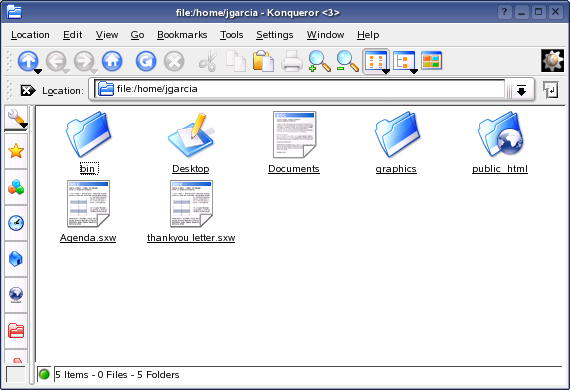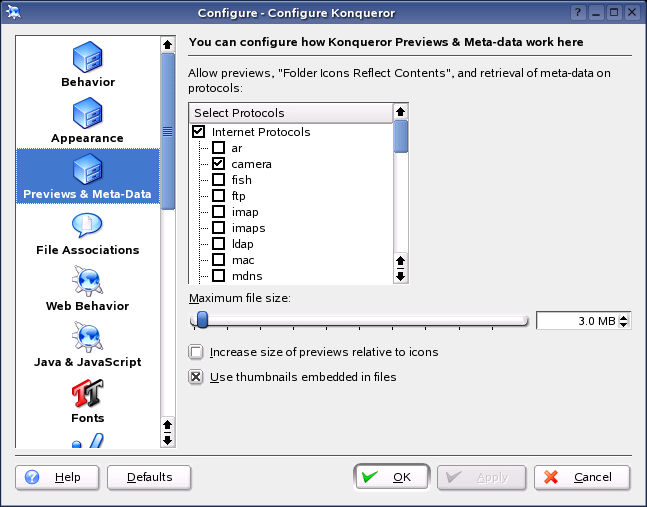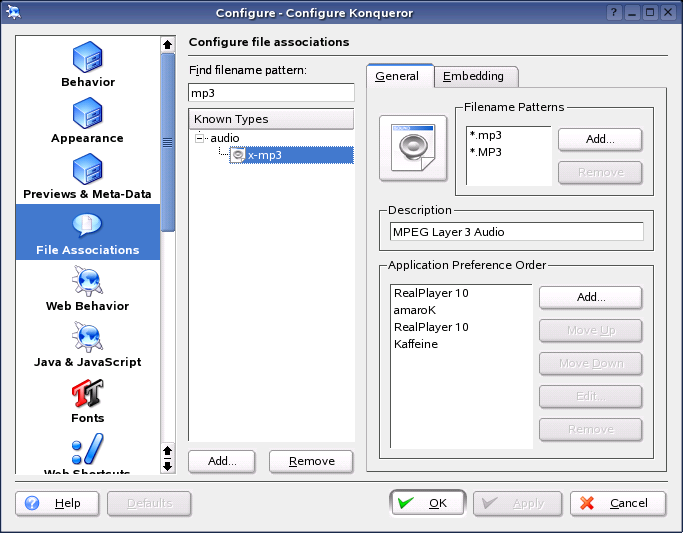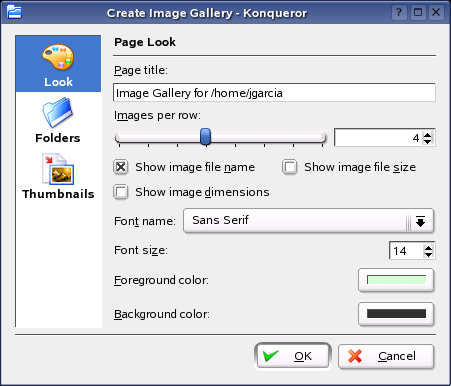2.4 Managing Folders and Files with Konqueror
Konqueror is a unified Web browser, file manager, document viewer, and image viewer. The following sections covers using Konqueror for file management.
Start Konqueror as a file manager by clicking the House icon
(![]() ) in
the panel. You can also press Alt+F2, then type konqueror $HOME.
The contents of your home directory are then displayed.
) in
the panel. You can also press Alt+F2, then type konqueror $HOME.
The contents of your home directory are then displayed.
Figure 17 The File Manager Konqueror

The file manager window consists of a menu bar at the top, a toolbar, and a location bar. The lower part of the window is split vertically into the navigation panel and the main window, which displays the contents. Use the icons on the left panel of Konqueror to display a navigation pane for items such as bookmarks and devices.
For information on using Konqueror as a Web browser, see The Konqueror Web Browser.
2.4.2 The Toolbar
The toolbar provides quick access to frequently used functions that can also be accessed via the menu. If you mouse over an icon, a short description is displayed. Right-click a free space in the toolbar to open a menu that allows you to change the position of the toolbar, switch from icons to text, change the icon size, and display or hide the individual bars. The configuration dialog can be started with Configure Toolbars. To the right, the toolbar features the Konqueror icon, which is animated while a directory or Web page is loaded.
2.4.3 The Location Bar
The location bar is preceded by a black symbol with a white X. If you click this icon, the contents of the line are deleted, allowing you to enter a new location. Valid locations can be path specifications, like the one that appears when the home directory is displayed, or Web page URLs. After typing an address, press Enter or click to the right of the input line. Access directories or Web pages visited recently via the down arrow to the right of the location bar so you don’t have to retype URLs if you need to access certain contents repeatedly. For even more convenience, create a bookmark.
2.4.4 The Main Window
The main window displays the content of the selected directory. If you click a file, the file is displayed in Konqueror or loaded into an application for further processing. If you click an RPM package, the description is displayed. Install the package by using Red Carpet® or the Install Package feature in YaST.
If you right-click an icon, a menu opens. The type of menu depends on the file type; common actions such as Cut, Copy, Paste, and Delete are available. Use Open With to select the application to open the file with. Files can be encrypted directly in Konqueror; however, to use this function, a key must be generated manually or in KGpg.
The quickest way to perform many actions is the drag-and-drop method. For instance, you can easily move files from one Konqueror window to another by simply dragging them. When you do this, you are asked whether the objects should be moved or copied.
2.4.5 File Preview
Konqueror can show you a preview of certain files. Normally this feature is switched on if you browse in a directory, and it only works if your Icon View is activated (click ). This feature is not always useful with packed (compressed) files, but if you mouse over a packed file, Konqueror opens a tooltip with additional information, such as the name, owner, and size.
You can change which files have a preview by clicking . Konqueror differentiates between Internet and local protocols. Each protocol can be activated.
Figure 18 Konqueror Previews & Meta-Data Dialog

2.4.6 File Associations
With Konqueror, you can decide which application should be used to open a file.
Figure 19 Konqueror Configure File Associations Dialog

-
In Konqueror, click .
-
To search for an extension, enter the extension in the Find Filename Pattern field.
Only file types with a matching file pattern appear in the list. For example, to modify the application for MP3 files, enter mp3 in the Find Filename Pattern field. You should see an entry for x-mp3 under the Audio heading.
-
Click the file type to open the setting dialog for this file type.
You can change the icon, the filename patterns, description, and the order of the applications.
If your tool is not listed, click in the Application Preference Order group box, then enter the command.
To change the order of the list entries, click the program you want to move, then give it a higher or lower priority by clicking or . The application listed at the top is used by default when you click a file of this type.
-
If you need a file type that is not listed in the Known Types list, click to open a dialog where you can select a group and enter a type name.
The group determines the main type, for example, audio, image, text, or video. Your file type can usually be assigned to one of these.
-
Click , then determine the extensions of the filename.
-
Specify a description in the text field and select which application to use.
-
-
Click .
2.4.7 Creating an Image Gallery
Konqueror can generate an HTML file with thumbnails to help you manage extensive image collections in a directory. Open the directory in Konqueror and click . A dialog opens where you can specify the background and foreground colors, the page title, the location to save the gallery to, and other settings. Click to start the action. By default, a file called index.html is created. If you click this file in Konqueror, your images are displayed in a miniaturized, organized view. Click an image to access its full-size view.
Figure 20 Konqueror Create Image Gallery Dialog
